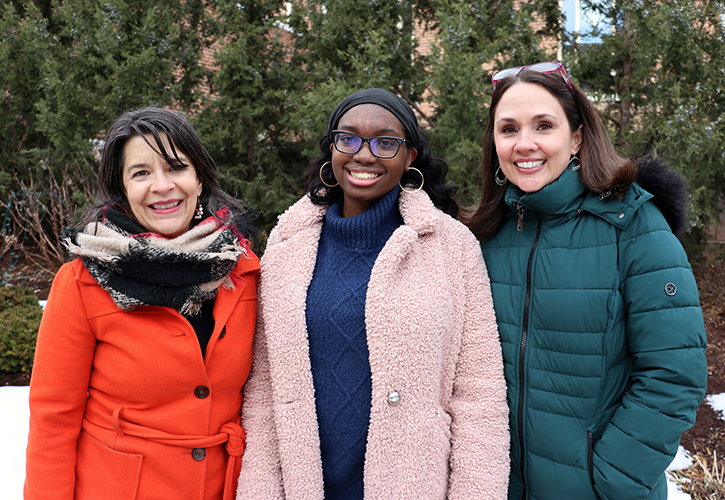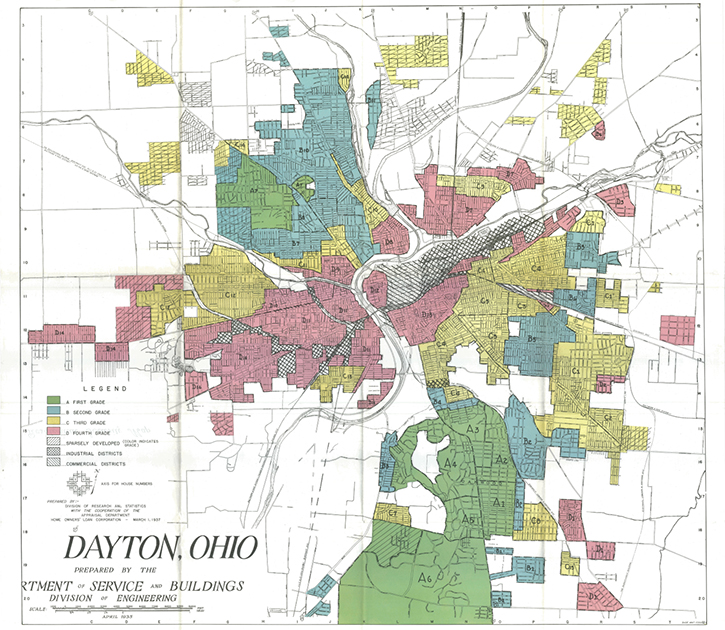College of Arts and Sciences Newsroom

University of Dayton conferences, ThinkTV documentary, and traveling exhibit explore impact of ‘redlining’ on Dayton region
By Dave Larsen
Federal home-ownership programs created as part of the 1930s-era New Deal used color-coded maps to delineate risk areas for government-backed mortgages in more than 200 U.S. cities and towns. Areas where property values were likely to go down — largely neighborhoods with Black residents — were outlined in red.
These so-called “redlining” maps barred many Black homeowners from qualifying for secure mortgages and loans, effectively embedding racial segregation and inequality into the development of American cities and suburbs.
“They are still impacting communities because most of our cities were formed and grew over the 20th century, so the way our cities are now was essentially shaped by those redlining maps, including highway construction that was implemented alongside the redlining practices,” said Nancy McHugh, executive director of the University of Dayton Fitz Center for Leadership in Community.
McHugh is one of many University faculty, staff and students taking part in a series of events this year that explore the impact of redlining on the Dayton region. The events include:
- UnDesign the Redline, an interactive exhibit featuring Home Owners’ Loan Corporation maps and area descriptions of Dayton that is traveling throughout the region during 2021-22. It includes community stories gathered by University students about area residents affected by redlining.
- Redlining: Mapping Inequality in Dayton and Springfield, a one-hour public television documentary that premieres at 9 p.m. Thursday, Feb. 24 on ThinkTV 16. Featuring commentary from University faculty, it tells the story of local families who were impacted by redlining, and the lasting effects of this federal policy on the region.
- The Common Good in a Divided City: Racism, The Church and the Challenge of Regional Solidarity. The free public conference, April 1-3 in the University Science Center, will bring together faith leaders, activists, policy-makers, scholars, community organizers and others to discuss regional solidarity, and the histories and structures that divide the region, with particular attention to the roles of race and faith.
- Imagining Community: Shaping a More Equitable Dayton, a free public symposium, April 7-8, at the Hub Powered by PNC Bank at the Dayton Arcade. It brings together community partners to explore the history, legacy and impact of Dayton’s racial segregation, and how to move toward a more just, equitable, and inclusive Dayton.
Despite their common theme, the raft of redlining-related events was somewhat serendipitous.
McHugh, who joined the University faculty in August 2021, approached ThinkTV Chief Content Officer Gloria Skurski with the idea for a redlining documentary while working at nearby Wittenberg University. Skurski connected her with Leslie Picca, the University of Dayton’s Roesch Chair in the Social Sciences, who was working with faculty and students to organize the Imagining Community symposium.
McHugh and Picca served as consultants for the documentary, which was produced by ThinkTV’s Richard Wonderling with associate producer Selena Burks-Rentschler. It features Picca among its interview subjects and promises some surprising discoveries.
“I’m not going to be a spoiler for it, but there are some really significant connections between our region and the government work with redlining that hasn’t really come out before,” McHugh said.
Picca and McHugh also served on the advisory team for the UnDesign the Redline exhibit, which was created by the New York-based organization Designing the WE. Local content was developed by community partners in Dayton, including students in Assistant Professor of English David Fine’s Literature and Ethics course, who gathered community stories.

“The Undesign the Redline exhibit has expanded the conversation about systematic racism beyond the humanities classroom,” said Kaitlin Hall, a junior sociology major from Nashville, Tennessee. “It tells the larger story of how we as a community continue to intentionally or unintentionally further the long legacy of racism in our city. At the end of the exhibit, members of the community can make a commitment, big or small, in dismantling systems of oppression.”
Hall, the Student Government Association’s director of campus unity, spoke at the exhibit’s October 2021 opening in the Roesch Library’s Stuart and Mimi Rose Gallery. She also is part of the team coordinating the Imagining Community symposium, which Picca said was inspired by the exhibit.
In addition to Roesch Library, the exhibit has been shown at Dayton Metro Library, Sinclair Community College and the Trotwood-Madison City School District. Currently, it can be seen at Wright State University. In March, it moves to Corinthian Baptist Church in Dayton. It will be displayed in the Arcade’s rotunda April 7-8 during the Imagining Community symposium.
“The exhibit is traveling around, it’s meant to be interactive, but we wanted to make sure that there was a space for these different conversations across the Miami Valley to come together,” Picca said. Her symposium co-organizers are McHugh and Misty Thomas-Trout, assistant professor of graphic design.
The symposium offers more than 30 concurrent sessions featuring local artists, community organizers, faith communities and scholars. Keynote speaker ShaDawn Battle of Xavier University will speak about Chicago Footwork, an embodied street dance of resistance and liberation.
The Common Good in a Divided City conference is organized by Kelly Johnson, the Fr. Feree Chair of Social Justice, and Vince Miller, the Gudorf Chair in Catholic Theology and Culture. It will focus on the need for regional solidarity, an issue championed by former University president Bro. Raymond Fitz.
The goal of these events is to inform people about the history of inequities in the region, and to listen and respond to those experiences.
“How do we make sure that community partners are talking with scholars, artists and other community residents,” Picca said. “We are intentionally creating space to ideally lay that foundation for enacting future change.”
For more information or to register for the events, visit the Imagining Community and The Common Good in a Divided City websites.
Photo: (left to right): Nancy McHugh, Kaitlin Hall and Leslie Picca.
